If you follow any of the genealogy blogs out there, the trend these days is to have at least one post each week that lists all the new records which have become available. These number in the hundreds of thousands. They include records from all over the world and can be as simple as a new batch of marriage records from some county in Alabama to additional digitization of parts of censuses and city directories. They are out there, waiting for us to type in a few search parameters and find them - from the comfort of our sofa or home office, often free of charge. Family Search prides itself on continuing to provide free, accurate, easily-accessible family history data to the public. The Library of Congress and the National Archives have tens of thousands of volunteers, people like you and me, working from home, to help do the same.
Information we need to research our genealogy doesn't get from a dusty box on a shelf in a foreign archive to our computer screen by magic. It becomes available because people just like us take a few hours every now and then to download a batch of records and index them.
At the end of this post I have copied the list published by
Geneaolgy In Time Magazine in their 25 April 2015 Newsletter.
It's a pretty impressive list - and it only covers part of the month of April. You will notice that the vast majority of these were made possible by the Family Search Indexing project.
D.I.R.T. is running an indexing contest through the end of October. The person who accumulates the most points indexing on Family Search wins. Our prize is a modest one - a genealogy reference book that any beginning family historian will find useful. But the real "prize" is the gift of helping provide digital records to our fellow genealogists and making knowledge available to all who want to search. It doesn't get much better than that.
So if you are currently working on racking up those points at Family Search by indexing records, keep up the good work! If you are not, it's not too late to start. If you don't know how, just talk to Denise and she will be happy to get you started.
We all know that there is no such thing as "free". In order for one person to be allowed access to something worthwhile at no cost to them, someone else must volunteer time and talent or make a monetary donation. Let's work together to do our part to make more records available to people just like us.
___________________________________________
Belgium – FamilySearch.org has indexed an additional 70,000 civil registration records from East Flanders, Belgium. These are birth, marriage and death records from the Belgium National Archives that span the period from 1541 to 1912. These records can be search by first name, last name and type of record. The underlying collection of some 2.8 million images can also be browsed. Access is free. [
East Flanders Birth Records]
Canada – FamilySearch.org has indexed an additional 246,000 records from their existing collection of Ontario marriages. This collection spans the years from 1869 to 1927. Although some jurisdictions in Ontario began recording marriages as early as 1801, province-wide registration did not begin until 1 July 1869. Also note that in the 1800s, people who lived near the US border sometimes chose to get married in the United States where marriage requirements could be less strict than in Canada. This collection can be searched by first name and last name. Access is free. [
Historic Ontario Marriage Records]
England – Deceased Online has added cemetery and cremation records from the Sandwell Metropolitan Borough, which is near Birmingham in the West Midlands. The new records consist of some 300,000 burials and 130,000 cremations going back as far as 1858. Access is by subscription. [
Sandwell Cemetery Records]
England – FamilySearch.org has a new image collection of Derbyshire parish records. This collection spans the years from 1537 to 1918 (basically from the formal start of parish record keeping under King Henry VIII to the end of World War I). The collection consists of some 53,000 images with the usual records on baptisms, marriages/banns and burials. Although some of the images can be searched by first name and last name, it is not clear if the entire collection is currently searchable. To learn more about English parish records, see the article
A Date Guide to English Genealogy. Access is free. [
Derbyshire Parish Records]
England – FindMyPast has seriously increased their collection of Yorkshire parish records. Over 1.2 million new baptism records from North Riding, East Riding and West Riding are part of the latest update. These records are from the original registers. In addition, 1.3 million new baptism records have also been added from bishop’s transcripts (basically transcribed records from the original parish records - these records were kept at the local bishop’s office). Both sets of baptism records span the years from the 1500s to 1914 (the start of World War I).
In addition, FindMyPast has added about 1.7 million parish marriage/bann records. These are both original parish records and bishop’s transcript records. Finally, there are about 1.8 million parish burial records that have also been added to their Yorkshire parish record collection. The records can be searched by first name, last name, place and year. Access is by subscription. [
Yorkshire Parish Records]
South Africa – FamilySearch.org has indexed some 43,000 names in their massive collection of estate files from Orange Free State, South Africa. This collection spans the years from 1951 to 2006. The two items in this collection that will be of particular interest to genealogists are death notices and will records.
A typical death notice (see image below) provides the name of the deceased, date and place of death, place of birth, name of parents, name of spouse and name(s) of children. A typical will record lists the name of the deceased, name of spouse, name of heirs/family members, date and place of the will and the names of witnesses to the will. This collection can be searched by first name and last name. Access is free. [
Orange Free State Death Notices]
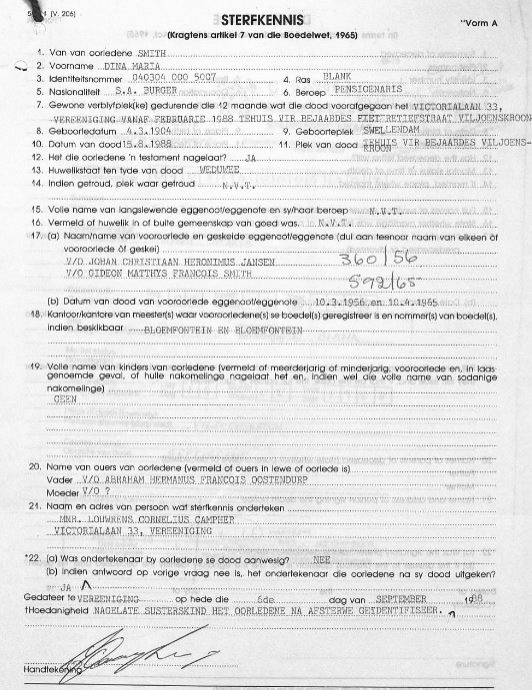
This legal death notice from Orange Free State, South Africa in 1988 provides a good deal of useful information to genealogists. Source: FamilySearch.org
US – FamilySearch.org has added some 700,000 indexed marriage records to their collection of Alabama marriage records. This collection spans the years from 1809 to 1950. To date, some 41% of the collection has been indexed. The collection can be searched by first name and last name. Alternatively, the one million images can also be browsed. Access is free. [
Alabama Marriage Records]
US – FamilySearch.org has indexed some 460,000 records from Cascade County, Montana. The collection spans the years from 1880 to 2009 and consists of an incredibly diverse set of records such as probate records (1903 to 1926), court orders for dependent children (1903 to 1937), naturalization records (pre 1945) and land deeds (1880 to 1941). Other types of records in the collection are cemetery records, election records, military records, school records, pension records, voter registration lists, census records, probate records and obituaries. The collection can be searched by first name and last name. Access is free. [
Historic Montana Genealogy Records]
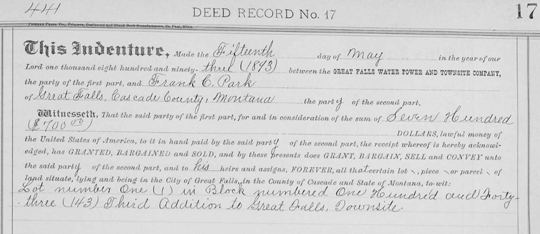
Above is an example of a Montana land deed from 1893 recorded in the official book of Cascade County. The image shows the first part of the record that provides a description of the land that was transferred between the Great Falls Water Power and Townsite Company and a Frank C Park. Source: FamilySearch.org
Czech – FamilySearch has put online an intriguing collection of some 66,000 school register images. These images span the years from 1799 to 1953 and come from the Opava State Regional Archive. They cover the Moravia region of the former Czechoslovakia. A typical record in this collection provides the full name of the child, date of birth, place of birth, religion, father’s full name and the place of residence. The records are in Czech and can be searched by district. A typical example is given below. Access is free. [
Historic Czech School Records]
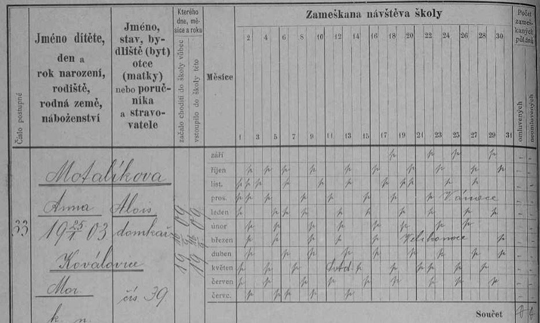
This school record from the former Czechoslovakia is a rare find. Now you can see if your ancestors really did pay attention in school.
UK – The website TheGenealogist is releasing several new collections this week. First up are 4.66 million World War I medal records. Included are records for the 1914 and 1915 star, the British war medal (1914 to 1920) and the Victory medal (1914 to 1919). TheGenealogist has also added 750,000 new parish records from 22 different counties. Finally, additional tithe maps have been release for more English counties.
A typical map lists the names of the owner and the occupier of lands in addition to details about the amount of land, how it was used and the tithe rent due. Tithe maps are very useful for geographically locating ancestors who lived in the countryside. Access to these new collections is by subscription. [
TheGenealogist]
Mexico – FamilySearch has indexed some 411,000 civil registration records from the state of Coahuila, Mexico. These are standard birth, marriage and death records and span the period from 1861 to 1998. The records can be searched by first name and last name. Access is free. [
Historic Coahuila Birth Records]
New Zealand – FamilySearch has added another 770,000 images to their collection of New Zealand probate records. This collection spans the years from 1843 to 1998. Some of the records are already indexed and can be searched by first name, last name, probate place and year. Access is free. [
New Zealand Probate Records]
Ireland – The birth, marriage and death indexes at IrishGenealogy.ie are now back online and available to search. They had gone offline several months ago (soon after they were put on the internet) over privacy concerns. Birth records over 100 years old, marriage records over 75 years old and death records over 50 years old can now be searched. You need to go through a process of giving your name and agreeing to the fact the search is for genealogical purposes. Note: these are just indexes, not the full digitized image. Access is free. [
Ireland Civil Registration Records]
IrelandIreland – The Irish Genealogical Research Society has put online copies of their annual journal The Irish Ancestor. The journal has been published since 1937 and contains hundreds of articles on Irish genealogy. The articles can be searched by family name and first name. See if someone has already published information on your Irish ancestors. Access is free. [
Irish Ancestor Journal]
US – The Plainfield Public Library of Plainfield, New Jersey has put online two new resources that will be of interest to genealogists. First is a collection of 75 local city directories that span the years from 1870 to 1982. The early city directories cover Rahway and Plainfield New Jersey, while the most recent directories appear to cover all of Union County.
This is an incredible resource for anyone who wants to track the exact address of their ancestors over many decades. The second resource is a collection of seven different early Plainfield newspapers that span the years from 1868 to 1916. Plainfield was officially incorporated in April 1869, so these two resources cover much of the area’s history. Access is free. [
Plainfield City Directories] [
Early Plainfield Newspapers]
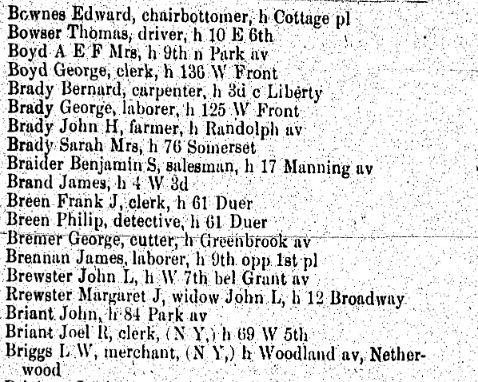
This Plainfield, New jersey city directory from 1881 appears to be fairly complete judging by the wide range of occupations in the listings. It is usually a good sign when it lists laborers and widows in addition to tradespeople. Each person is listed by full name, occupation and home address. Notice the first person on the list has an occupation listed as "chairbottomer".
Australia – FindMyPast.com has put online early editions of the government gazette of New South Wales. The collection spans the years from 1832 (the start of the gazette) to 1863. This was the official newspaper of record for the state government. It was used as a means of communication between the government and the general public. It recorded a broad spectrum of community matters such as land sales, court notices, petitions, licenses, contracts, police activity, etc.
The gazette also contains a considerable amount of detailed information on convicts. For example, the 1833 gazette provides lists of all male convicts, when they arrived in the colony, ship name, occupation and convict number. Records on government employees are also prominent in the gazette. There are some 1.2 million original transcripts in the collection. The collection can be searched by first name, last name and year. Access is by subscription. [
New South Wales Government Gazette]
UK – FamilySearch has put online some 10 million records from Westminster rate books. A rate book was essentially a property tax book. In the early days, these books were prepared by local parishes, which were responsible for maintaining roads, sewers, lighting, etc. This collection covers the period from 1634 to 1900 from the city of Westminster (now an inner borough of central London). A typical record lists the head of household, the owner, the street address and the rate owed. The collection can be searched by first and last name. Since this collection comes from FindMyPast, the original image can only be viewed at a family history center. Access is free. [
Westminster Rate Books]
UK – Harvard University has begun a multi-year project to put online their collection of early English manor rolls. These are court rolls, account rolls and other documents from various English manors. They range in date from 1282 to 1770. The largest collection comes from Cheshire, with additional rolls from Hampshire, Sussex, Staffordshire and Suffolk. At the moment, this collection is not searchable. Access is free. [
Early English Manor Rolls]
US – FamilySearch has indexed some 1.3 million additional Texas marriage records. The records span the years from 1837 to 1977. They can be searched by first name and last name. This collection currently covers 183 out of 254 counties in Texas. A typical record lists the name of the bride and groom, date of marriage and who officiated at the marriage, as shown below. Access is free. [
Historic Texas Marriage Records]
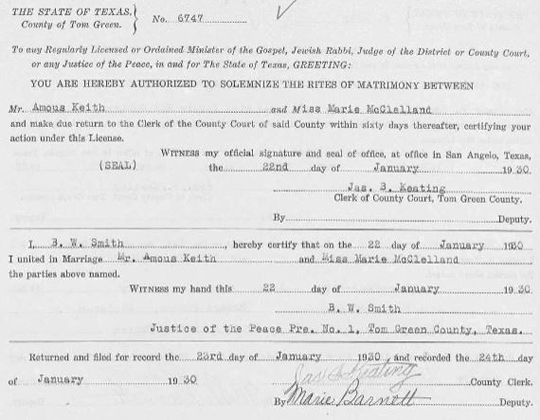
This is a typical Texas marriage record from 1930. It provides the name of the bride and groom, who officiated at the marriage and the date of marriage.
Ireland – The Irish Newspaper Archives has added 7 new historic newspaper titles from County Kerry in the south-west region of Ireland. The newspapers span the years from 1828 to 1920. Access is by subscription. [
Historic Kerry Newspapers]























